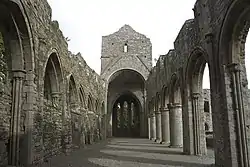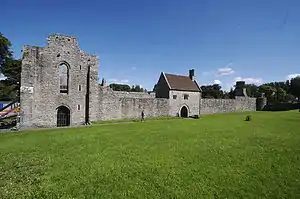Boyle Abbey
Boyle Abbey (Irish: Mainistir na Búille) was the first successful foundation in Connacht of the Cistercian order which had opened its first Irish house at Mellifont, County Louth, in 1142.
Mainistir na Búille | |
 The interior of Boyle Abbey, looking east through the nave | |
 Location within Ireland | |
| Monastery information | |
|---|---|
| Order | Cistercians |
| Established | 1218 |
| Disestablished | 1592 |
| Diocese | Elphin |
| People | |
| Founder(s) | Mac Diarmada family |
| Architecture | |
| Status | Inactive |
| Style | Cistercian |
| Site | |
| Location | Boyle, County Roscommon, Ireland |
| Coordinates | 53°58′25″N 8°17′49″W |
| Public access | Yes |
| Official name | Boyle Abbey |

History
In the 12th century Malachy of Armagh (later St. Malachy) became aware of two new monastic orders in France, the Cistercians and the Cannons Regular of St. Augustine and he decided to introduce both orders to Ireland in an effort to reform the old Irish church which, both morally and organizationally, had fallen out of line with much of the rest of Christian Europe.
The first Cistercian Abbey was founded at Mellifont, Co. Louth. St. Malachy made arrangements that young aspirant Irish men who want to become Cistercians should be trained in St. Bernard’s own monastery of Clairvaux or one of its daughter houses.
The Cistercians wanted to found an abbey in Moylurg as a daughter house of Mellifont and they did try to find a suitable place. They tried Grellachdinach and Drumcunny. By 1148 the Celtic monastery of ATH-DA-LARAG had either very few monks or none at all. So Taoiseach McGreevy, a local chieftain, negotiated and gave the Celtic monastery of ATH-DA-LARAG in "pure free and perpetual alms" (no strings attached) to the Cistercians. (Documentary evidence shows that the McGreevys were still in this district one hundred years later, ca. 1258.)
The Cistercians were welcomed and given land grants of about 50,000 acres (200 km2) scattered west of the River Shannon in 27 out-farms called granges. The Cistercians respected their Celtic monastic buildings. They did not demolish them, but joined their own buildings onto the original ones at ATH-DA-LARAG.
This took time and the Cistercian buildings were not completed until ca. 1218 when the abbey was consecrated and called the Abbey of Boyle (Boyle Abbey). The transition may be seen in the architecture, the two styles of buildings etc. and the stump of the Round Tower).
Their initial success was phenomenal, as Mellifont sent out its monks to found one daughter house after another within a decade of its foundation. For some as yet unexplained reason, the Cistercians found it difficult to find a permanent home for themselves in Connacht, making three false starts before they finally settled at Boyle in 1161 beside a small river that flows into Lough Key. Their original patrons were the McGreevys, lords of Moylurg and later, after a power struggle, the MacDermott. But, perhaps because money was short, building progress was slow, and the church must have taken about sixty years to complete, going from east to west until the final portion was completed around 1220. The monastery was laid out according to the usual Cistercian plan, a church on the north side of a roughly rectangular cloister area, with a chapter house for meetings of the monks on a second side, a kitchen and a refectory on the third, and probably store houses and dormitory above on the fourth.
But only small parts of the cloister survive, because it was turned into a barracks by the Elizabethans in 1592, and the Cromwellians who besieged it in 1645 and executed the remaining monks within. This, along with possible later stone quarrying, ensured that little survives. Despite this, the ruins are impressive, dominated by a squat square tower that was added above the crossing sometime in the thirteenth century. The church adheres to the Cistercian canon in having a nave with side aisles, a transept to the north and south of the crossing, each with a pair of chapels in the east wall, and a chancel, whose original windows were replaced in the thirteenth century. The design was influenced by styles from Burgundy, from whence the Cistercians came to Ireland, but much of the detailing of the nave and particularly the cylindrical piers of the south arcade has strong echoes of the West of England. The decorated corbels and capitals belonging to them were probably carved by local masons, some of them members of the so-called ‘School of the West’, creating some of the most inventive architectural sculpture of the early thirteenth century in the West of Ireland.
Today
The Abbey is now a national monument in state care. Admission is inexpensive, with a family pass costing only 16 euro. It is located in Boyle, County Roscommon.
Australian connection.
A small piece of stone from the Abbey was carried to the other side of the world. Being placed on the monumental headstone of an Irishman Bartholomew Higgins in the Rookwood Necropolis Sydney Australia.
References
- Boyle Abbey at Ireland West
See also
- List of abbeys and priories in Ireland (County Roscommon)
External links
- Boyle Abbey - official site at Heritage Ireland